

Building Envelope Design Guide - Glazing. ETFE systems - Fabric Architecture. ETFE moves mainstream Fabric Architecture | September 2011 By Edward M Peck, AIA, LEED AP What is ETFE?
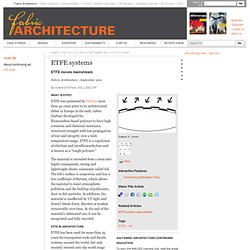
ETFE was pioneered by DuPont more than 40 years prior to its architectural debut in Europe in the early 1980s. DuPont developed the fluorocarbon-based polymer to have high corrosion and chemical resistance, structural strength with low propagation of tear and integrity over a wide temperature range. The material is extruded from a resin into highly transparent, strong and lightweight sheets commonly called foil. Effect of Microstructure of Spongy Bone in Different Parts of Woodpecker’s Skull on Resistance to Impact Injury. Design in Nature: Learning from Trees - Claus Mattheck.
The chicken bone which you nibbled and threw away yesterday was a high-tech product!

In fact it was a superlative light-weight design functionally adapted to the mechanical requirements. No engineer in the world has as yet been able to copy this structural member, which is excellently optimized in its external shape and its internal architecture as regards minimum weight and maximum strength. CAO and SKO design software. CAO (computer-aided optimization) and SKO (soft kill option) software was developed by Claus Mattheck at the Karlsruhe Research Centre in Germany.

The CAO and SKO software works with FEM (Finite Element Model) used in engineering design. FEM is a numerical tool that breaks a component of interest into finite geometrical sections, then defines the material property of each finite element. FEM identifies areas of high stress, and shows the simulated effects of adding or removing material based on CAO and SKO. Adam Opel GmbH, a part of General Motors Engineering Europe, used mostly the SKO to make car components lightweight but still strong enough to withstand stress. An Opel engine mount designed using the software is 25 percent lighter yet 60 percent more stable than one designed using the conventional design process. Cancellous bone. A N D R E S H A R R I S » 1.0 Biomimetics. Structure Optimisation_Cancellous Bone Tissues: High Strength to Weight ratio An interesting example of lightweight, redundant and highly-differentiated structures in nature, which drive the biomimetic research in order to derive morphological and performance properties that will inform the design process of our project, is found in bone tissues, especially bird skulls tissues.
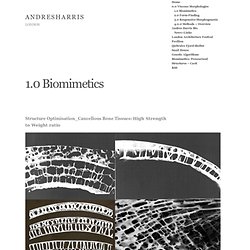
Skulls in general are extraordinary impact-resistant structures and extremely light at the same time as they protect the most important organs of an animal body and this performance and physical property can be applied in structure or architecture design. ‘Lightweight’ can be defined by the ratio of the active or life load is carried over its dead load, being the longer the better; in other words, the more loads a structure can carry with least structural inherent weight, the better. King's Cross 'vest' structure to be unveiled at London railway station as part of £500m revamp. By Ray Massey Published: 00:05 GMT, 14 March 2012 | Updated: 08:44 GMT, 14 March 2012 It may look like a gigantic stretched string vest.

But this vast super-strong lattice-work roof is the record-breaking centre-piece of one of Britain's biggest and most famous stations - King's Cross - restored with a 21st century twist to its greatness as a railway gateway to the North. The £500million restoration of the 160-year old Grade 1 listed building is part of a further £2.2billion redevelopment of the once shabby and rather disreputable King's Cross area. Gateway to the North: The new concourse at King's Cross, which has undergone a significant revamp 21st century twist: A super-strong domed roof, constructed from 1,200 tonnes of steel, lets natural light in The station already serves 45 million people a year – including magical Harry Potter and his friends from the mystical Platform 9 and ¾ - but that is set to rise by 10 million more within the decade. A lower funnel stretches to the roof.
Cellulose. How 3D Printing Will Change Our World (Part II) Today, 3D Printing technology lives in the realm of small plastic tchotchkes. But economists, theorists, and consumers alike predict that 3D printers will democratize the act of creation and, in so doing, revolutionize our world. Recycled print. 3D printers generally print in one of two types of plastic; either ABS, which is used to make Legos, or PLA, typically found in some types of food packaging.
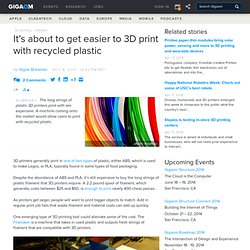
Despite the abundance of ABS and PLA, it’s still expensive to buy the long strings of plastic filament that 3D printers require. A 2.2 pound spool of filament, which generally costs between $25 and $50, is enough to print nearly 400 chess pieces. As printers get larger, people will want to print bigger objects to match. Add in regular print job fails that waste filament and material costs can add up quickly. One emerging type of 3D printing tool could alleviate some of the cost. CNSILK. ETFE Foil. Orproject. clean air, ETFE. Why be resource efficient. Julian Allwood. Sustianable materials. Energy effiecient glass.
Panelite develops innovative, energy-efficient materials for architecture.
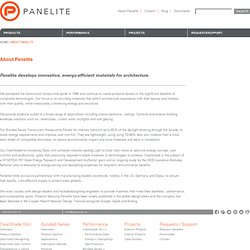
We pioneered the translucent honeycomb panel in 1998 and continue to create products based on the significant benefits of composite technologies. Our focus is on providing materials that enrich architectural experience with their beauty and impress with their quality, while measurably conserving energy and resources. We provide products suited to a broad range of applications including interior partitions, ceilings, furniture and exterior building envelope solutions such as clerestories, curtain walls skylights and roof glazing. Our Bonded Series Translucent Honeycomb Panels for interiors transmit up to 65% of the daylight entering through the facade, to lower energy requirements and improve user comfort. They are lightweight, using using 70-80% less raw material than a solid resin sheet of comparable thickness, to reduce environmental impact and save materials and labor in installation.
Hexagon (for eden) inspried by bamboo. Alexander Graham Bell may be considered the first to construct modular space grids.
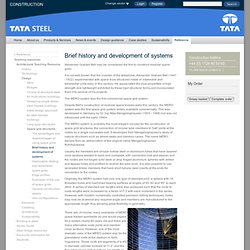
It is not well known that the inventor of the telephone, Alexander Graham Bell (1847 -1922), experimented with space truss structures made of octahedral and tetrahedral units early in this century. He appreciated the dual properties of high strength and lightweight exhibited by these rigid structural forms and incorporated them into several of his projects. The MERO system was the first commercial space grid system. Despite Bell's construction of modular space trusses early this century, the MERO system was the first space grid system widely available commercially.
This was developed in Germany by Dr. The MERO system is probably the most elegant concept for the construction of space grid structures, the connection of circular tube members to 'ball' joints at the nodes by a single concealed bolt. Tonkin lui and ed clark 'shells'